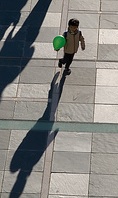 The other day, my daughter asked me what time it was. I gazed up at the sun and told her it was 3:30 pm. She checked her watch, and then in astonishment asked me how I knew the time. She had no idea that you could tell time from the sun, even after we had just visited the Sundial Bridge and read the time from its cast shadows. I was reminded of a project I used to do as part of a unit on solar energy when I was teaching K-8: Human sundials.
The other day, my daughter asked me what time it was. I gazed up at the sun and told her it was 3:30 pm. She checked her watch, and then in astonishment asked me how I knew the time. She had no idea that you could tell time from the sun, even after we had just visited the Sundial Bridge and read the time from its cast shadows. I was reminded of a project I used to do as part of a unit on solar energy when I was teaching K-8: Human sundials.
To help children learn how the sun moves across the sky and how shadows are formed, the human sundial project takes a whole day. First thing in the morning when the sun is up, go outside with your child and trace their shadow with some chalk. Mark an X where your child is standing so they can return to the same spot. Switch roles and have your child trace your shadow in a different spot. Then, return every hour and repeat tracing your shadows and recording the time on each shadow. By the end of the day, your child will see how their shadow moves in accordance with the sun’s path, as well as changes shape.
Learning to tell time is a mathematical content standard taught during the primary grade levels; however, most children are not taught the connection between and the passage of time and the Earth’s movements. By becoming a human sundial, children learn these connections in a way that makes sense to them. Planet Earth is a unique place!
Happy Earth Day!
Image: Flikr chez_sugi
What a lovely activity! Thanks for sharing.
Cool idea!